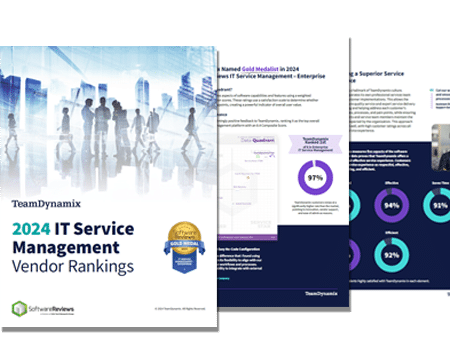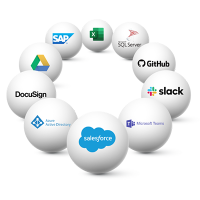
Unlocking ITSM Excellence: The Power of KPIs and Metrics
For nearly all organizations, IT Service Management (ITSM) stands as the backbone of operational efficiency, ensuring that IT services align not just with the needs

The Info-Tech ranking report offers a unique view of the market based entirely on in-depth customer interviews. Download the Info-Tech ITSM Quadrant and Customer Viewpoint report today.

We’ll show you some of our best situations and show you exactly how to execute them to get immediate results. The best part is, iPaaS tools often feature easy-to-use click and drag functionality, meaning you don’t need a dedicated employee building integrations and workflows.

System Integrators, Value Added Resellers, Technology Providers, and Buying Consortiums can benefit from a partnership with TeamDynamix.

The Info-Tech ranking report offers a unique view of the market based entirely on in-depth customer interviews. Download the Info-Tech ITSM Quadrant and Customer Viewpoint report to gain a better understanding of key vendor strengths and emerging market requirements.
As organizations continue to rapidly grow their tech stacks, IT leaders are struggling to keep up with demands for integration and automation between applications.
A recent market study by TeamDynamix and IDG found 89% of companies surveyed said they are dealing with data integration backlogs, even if using a third party to help. In addition, 74% say they simply don’t have enough resources to handle the integration workload.
Usually, integration debt builds over time as more and more applications, systems and databases are brought into the enterprise system landscape. However, the pace of new tech adoption is on the rise, and IT leaders simply can’t keep up with demand. Compounding these issues, many organizations are still using point-to-point integrations, APIs, PowerShell scripts and ETL utilities to move data and create automation. This is an enormous drain on IT as each requires deep technical expertise. In the end, lines of business are starting to look for a new way forward that offers faster connectivity with less reliance on highly technical issues.
“In the last year we’ve taken a huge leap in technology, but it’s also created a bit of a digital divide,” Saby Waraich, CIO at Clackamas Community College said at a recent TeamDynamix event. “We need to find the right balance between modernization and disruption.”
At Raymour and Flanigan Ralph DiVito, Team Leader of Technology and Business Intelligence, said retail has been extremely dynamic with a lot of disruptors – especially in the furniture and mattress markets where Raymour and Flanigan compete.
“Our technology strategy, as a result, is dynamic but it really needs to align with our organizational vision of driving the best customer and employee experience,” DiVito said. “We’ve been working on a technology roadmap that really allows a customer to do business with us at any time, while also making sure that our teams on the back end have the tools they need to execute on behalf of the customer. We’re really focused on technology that removes friction from the customer experience.”
That’s where iPaaS can be useful.
Modern integration and automation platforms – also referred to as iPaaS – help to address the problems of growing integration debt by making it quick and easy to connect any systems you bring on board with the rest of the organization. This means that IT teams can satisfy the demand without coding, development, script writing and point-to-point integration.
iPaaS is built for the kind of quick deployment teams need to avoid creating and accumulating new integration debt because it’s so easy to create new connections leveraging a library of pre-built connectors. Once connected, automation can easily be created using a codeless drag and drop interface. Smaller teams can connect new applications without needing long development time and a team of developers.
Common systems that can be integrated include CRM, ERP and more – for instance, many organizations have an ecosystem of systems that sit around core platforms such as Workday, MUNIS, Banner, Salesforce and more. With iPaaS, the ecosystem can easily be connected to help synchronize data and create workflows to prevent manual processing and redundant data entry.
iPaaS is built with both IT professionals and business users in mind. Its no-code functionality means anyone can connect systems with pre-built connectors. Enterprise teams can take advantage of the full suite of features provided by iPaaS including visual workflow building, API management, real-time troubleshooting, scalability, security, and governance. Your team will not need to build custom integration code.
By using a platform like iPaaS you can empower both your developers and lines of business throughout your organization to leverage hundreds of connectors to integrate systems within a single hub for easy oversight and auditing.
To learn more about what you can do with iPaaS check out our eBook: What’s in Your Cloud? Enterprise Integration Playbook: Saving Time with iPaaS.

For nearly all organizations, IT Service Management (ITSM) stands as the backbone of operational efficiency, ensuring that IT services align not just with the needs

The IT service desk plays a critical role in any organization, serving as the primary point of contact between customers/end users and the IT support

Did you know that a significant number of IT incidents occur when someone makes a change to one system that then affects other systems in
TeamDynamix’s award-winning SaaS cloud solution offers IT Service and Project Management together on one platform with enterprise integration and automation.
[email protected]
(877) 752-6196
Contact Us
